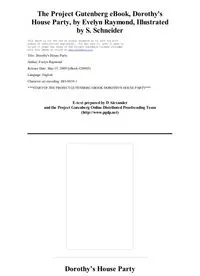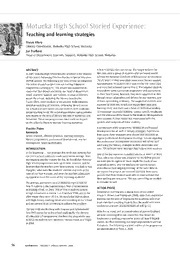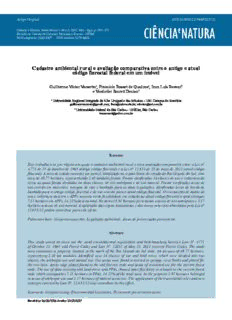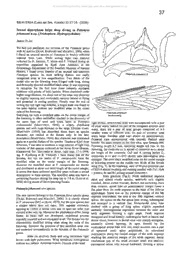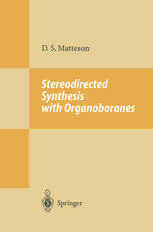
Stereodirected Synthesis with Organoboranes PDF
Preview Stereodirected Synthesis with Organoboranes
Reactivity and Structure Concept in Organic Chemistry Volume 32 Editors Klaus Hafner Jean-Marie Lehn Charles W. Rees P. von Rague Schleyer Barry M. Trost Rudolf Zahradnik Springer Berlin Heide1berg NewYork Barcelona Budapest Hong Kong London Milan Paris Tokyo Donald S. Matteson Stereodireeted Synthesis with Organoboranes With 14 Tables t Springer Prof. Dr. Donald S. Matteson Washington State University Department of Chemistry Pullman, W A 99164-4630 USA ISBN-13: 978-3-642-79711-8 e-ISBN-13: 978-3-642-79709-5 DOr: 10.1007/978-3-642-79709-5 Cip dataapplied for This work is subject to copyright. All rights are reserved, whether the whole or part of the material is concerned, specifically the rights of translation, reprinting, reuse of illustrations, recitation, broadcasting, reproduction on microfilm or in other ways, and storage in data banks. Duplication of this publication or parts thereof is permitted only under the provisions of the German Copyright Law of September 9, 1965, in its current version, and permission for use must always be obtained from Springer Verlag. Violations are liable for prosecution act under German Copyright Law. © Springer-Verlag Berlin Heidelberg 1995 Softcover reprint ofthe hardcover 1st edition 1995 The use of general descriptive names, registered names, trademarks, etc. in this publication does not imply, even in the absence of a specific statement, that such names are exempt from the relevant protective laws and regulations and therefore free for general use. Product liability: The publisher cannot guarantee the accuracy of any information about dosage and application contained in this book. In every individual case the user must check such information by consulting the rlevant literature. Typesetting: Data-conversion by M. Schillinger-Dietrich SPIN:10494277 5113020-543210 -Printed on acid -free paper Contents 1 Introduction to Borane Chemistry ............ ............ ....................... ........... 1 1.1 Beginnings .......................................................................................... 1 1.2 Structure and Bonding in Organoboranes .. ...... ...... ............ .......... ....... 2 1.2.1 General Characteristics of Boranes . ...... ...... ....... ..... ........... ..... 2 1.2.2 Size. ........................ ...... ........... ........ .... ........ ........................ .... 2 1.2.3 Bond Strengths ...... .... ........ ........ ...... ...... ......... ......... ..... ........... 4 1.3 General Chemical Properties of Organoboranes. ...... ....... ... ................ 7 1.3.1 Oxidation States of Boron ....................................................... 7 1.3.2 Ligand Exchange on Boron ..................................................... 10 1.3.3 Acidities ................................................................................... 13 1.4 Safety Considerations ......................................................................... 15 1.4.1 General Hazards ...................................................................... 15 1.4.2 Laboratory Handling ........ ........... ...... ...... ...... ............ ....... ........ 17 1.5 References........................................................................................... 18 2 Sources of Compounds Containing Boron-Carbon Bonds ................. 21 2.1 Industrial Sources ofBoron Compounds ............................................ 21 2.2 The Organometallic Route .................................................................. 21 2.2.1 Boronic Esters.. ... .............. ...... ... ...... ...... ...... ................ ..... ... .... 21 2.2.1.1 Grignard and Lithium Reagents ................................. 21 2.2.1.2 Other Organometallics .......... ........ .............. ..... ...... .... 24 2.2.2 Di-, Tri-, and Tetraborylmethanes ........................................... 25 2.2.3 Borinic Esters (Dialkylalkoxyboranes) ................................... 25 2.2.4 Trialkylboranes .... ... ... ... ........... ...... ...... ............. ....... ... ......... .... 26 2.3 Hydroboration .................. ............ ........ ...... ...... ........... ..... ................... 27 2.3.1 General Considerations ............................................................ 27 2.3.2 Mechanism of Hydroboration .................................................. 29 2.3.3 Hydroborating Agents .............................................................. 31 2.3.3.1 Borane Sources .......................................................... 31 2.3.3.2 Alkylborane reagents ................................................. 31 2.3.3.3 Oxygen substituted hydroborating agents .................. 32 2.3.3.4 Haloboranes ............................................................... 33 2.3.4 Catalyzed Hydroborations ....................................................... 35 2.4 Haloborations ...... ..... ............... ... ... ...... ... ........ ......... ...... .... ........... ....... 40 2.5 Other Routes to Carbon-Boron Bonds. ........... ........ ..... ....... ............. 41 2.6 References. ..... ....... ............ ......... ......... ...... ......... .... ........... ..... ............. 44 VI Contents 3 General Reactions of Organoboranes ............ ..... .................................... 48 3.1 Introduction ......................................................................................... 48 3.2 Oxidative Replacement of Boron ........................................................ 48 3.2.1 Introduction ............................................................................. 48 3.2.2 Oxygen Electrophiles .............................................................. 49 3.2.2.1 Hydrogen peroxide..................................................... 49 3.2.2.2 Migratory aptitudes .................................................... 51 3.2.2.3 Sodium perborate and other peroxides ...................... 51 3.2.2.4 Trimethylamine N-oxide ............................................ 53 3.2.2.5 Molecular oxygen ...................................................... 53 3.2.2.6 Other reagents ............................................................ 53 3.2.3 Nitrogen Electrophiles ............................................................. 54 3.2.3.1 Chloramine and hydroxylaminesulfonic acid ............ 54 3.2.3.2 Alkyl azides ............................................................... 55 3.2.3.3 Rearrangement of a-aminoboranes ............................ 57 3.2.4 Halogenation ............................................................................ 59 3.2.4.1 Stereoselective replacements ..................................... 59 3.2.4.2 Halogenation at carbon adjacent to boron ................. 59 3.2.5 Sulfur ....................................................................................... 60 3.2.6 Protonolysis ............................................................................. 60 3.2.7 Metalation ................................................................................ 62 3.3 Boron Substituted Carbanions ............................................................ 63 3.3.1 By Deboronation...................................................................... 63 3.3.2 By Destannylation ................................................................... 65 3.3.3 By Deprotonation .................................................................... 65 3.3.4 By Michael Addition ............................................................... 69 3.4 Replacement of Boron by Carbon ....................................................... 71 3.4.1 Introduction ............................................................................. 71 3.4.2 ß-Eliminations as Nuisance Reactions .................................... 71 3.4.3 Migrations to Electron-Deficient a-Carbon ........................... 72 3.4.3.1 Introduction ................................................................ 72 3.4.3.2 Discovery of process and mechanism ........................ 73 3.4.3.3 Favored reaction pathways ........................................ 73 3.4.3.4 Routes to a-haloalkylboron compounds .................... 74 3.4.3.5 The stereocontrollable route to halo boronic esters ... 77 3.4.3.6 Alkylation of (halomethyl)boronic esters .................. 78 3.4.3.7 Simple homologation ofboronic and borinic esters .. 79 3.4.3.8 Rearrangement of a,b-unsaturated borates ................. 80 3.4.3.9 Carbonylation and cyanidation .................................. 82 3.4.3.10 Other chain extensions ............................................... 86 3.4.4 Displacement of Boron by Electrophilic Carbon .................... 88 3.4.4.1 Polar displacements ................................................... 88 3.4.4.2 Small ring formation .................................................. 89 3.4.4.3 Radical displacement mechanisms ............................ 91 3.4.5 Allylborane Chemistry ............................................................ 92 Contents VII 3.4.5.1 Introduction .............................................................. .. 92 3.4.5.2 Triallylborane ............................................................ . 92 3.4.5.3 Intramolecular allylic rearrangements ...................... . 95 3.4.5.4 Allylic bisboranes .................................................... .. 96 3.4.5.5 Three-carbon chain extension ofboronic esters ...... .. 98 3.4.5.6 3-Borolenes ............................................................... . 99 3.4.5.7 Allenyl and propargyl boranes .................................. . 100 3.4.6 Photochemical Rearrangements ............................................ .. 101 3.5 Reactions at Sites Other than the B-C Bond .................................... .. 104 3.5.1 Introduction ............................................................................ . 104 3.5.2 Nucleophilic Reactions of a-Halo Boronic Esters .................. . 104 3.5.2.1 Displacements ........................................................... . 104 3.5.2.2 Eliminations .............................................................. . 106 3.5.3 a-Bromination ......................................................................... 106 3.5.4 Oxidations of Other Functions in the Presence of C-B Bonds ....................................................................................... 107 3.5.5 Additions to Double Bonds ..................................................... 108 3.5.5.1 Radical additions........................................................ 108 3.5.5.2 Polar and catalytic additions ...................................... 109 3.5.5.3 Cycloadditions ........................................................... 110 3.5.5.4 Cyclopropanation ....................................................... 111 3.6 References ........................................................................................... 112 4 Alkenylboranes and Control of Oletinic Geometry .......... ..................... 120 4.1 Introduction ......................................................................................... 120 4.2 ß-Elimination Routes to Unsaturated Compounds ............................. 120 4.2.1 Simple Alkenes ........................................................................ 120 4.2.1.1 Introduction ................................................................ 120 4.2.1.2 Stereochemistry .......................................................... 121 4.2.1.3 Fragmentation ............................................................ 122 4.2.1.4 Alkenes from enamines .............................................. 122 4.2.2 Routes to Alkenylboranes ........................................................ 123 4.2.2.1 (E)-I-Alkenylboranes from l-alkynes ....................... 123 4.2.2.2 Alkenylboranes from disubstituted alkynes ............... 124 4.2.3 Inversion of (E)-to (Z)-Alkenylboranes .................................. 130 4.2.4 Other Routes to Alkenylboranes .................................. ............ 134 4.2.5 The ZweifelOlefin Synthesis .............................. .................... 136 4.3 The Suzuki Coupling Reaction ........................................................... 139 4.3.1 Scope ofthe Reaction .............................................................. 139 4.3.2 Synthetic Applications ............................................................. 149 4.4 Other Stereoselective Routes to Alkenes ............................................ 155 4.4.1 Alkenylpropargylic and Alkenylallenic Boranes ..................... 155 4.4.2 Insertion into Carbon-Boron Bonds ........................................ 156 4.4.3 a,ß-Unsaturated Ketones from Boron Enolates ........ ,............ 157 4.5 References ........................................................................................... 158 VIII Contents 5 Asymmetrie Synthesis via (a-Haloalkyl)boronie Esters ........................ 162 5.1 Introduction......................................................................................... 162 5.1.1 Overview................................................................................. 162 5.1.2 Nomenclature Notes ................................................................ 163 5.1.2.1 Chirality descriptors ................................................... 163 5.1.2.2 Bond illustration conventions .................................... 164 5.1.2.3 Drawings ofbicyclic structures ................................. 165 5.2 Synthetic Methodology: Pinanediol Esters ........................................ 165 5.2.1 Original Process ....................................................................... 165 5.2.1.1 Preparation ofpinanediol........................................... 165 5.2.1.2 Discovery of pinanediol boronic ester chemistry ...... 166 5.2.1.3 Epimerization of(a-chloroalkyl)boronic esters ......... 168 5.2.2 Zinc Chloride Promotion of a-Halo Boronic Ester Formation................................................................................. 169 5.2.3 Functional Group Compatibility.............................................. 171 5.2.3.1 Alkoxy substituents .................................................... 171 5.2.3.2 An azido substituent ................................................... 173 5.2.3.3 Thioether substituents ................................................ 175 5.2.3.4 Halogen substituents .................................................. 175 5.2.3.5 Carboxylic ester substituents ..................................... 175 5.2.3.6 Unsaturated boronic esters ......................................... 176 5.2.4 Quatemary Chiral Centers ....................................................... 177 5.2.5 Pinanediol Recovery ................................................................ 179 5.2.6 Nonequivalent Faces of Boron in Pinanediol Esters ............... 180 5.3 Synthetic Methodology: Chiral Directors Having C Symmetry ....... 181 2 5.3.1 Butanediol Esters ..................................................................... 181 5.3.1.1 Synthetic routes made possible by C symmetry ....... 181 2 5.3.1.2 Nomenclature of cyclic boronic esters ....................... 183 5.3.2 Diisopropylethanediol (DIPED) Esters ................................... 183 5.3.2.1 Introduction ................................................................ 183 5.3.2.2 Synthesis of DIPED ................................................... 183 5.3.3 Dicyclohexylethanediol (DICHED) Esters ............................. 184 5.3.3.1 Introduction ................................................................ 184 5.3.3.2 Synthesis of DICHED ................................................ 184 5.3.4 Ultrahigh Stereoselectivity with C2 Symmetry ....................... 185 5.3.4.1 Introduction ................................................................ 185 5.3.4.2 Background ................................................................ 185 5.3.4.3 Discovery of enhanced selectivity ............................. 185 5.3.4.4 Kinetic resolution ....................................................... 186 5.3.4.5 Mechanistic interpretation ......................................... 187 5.3.5 Convergent Connection of Two Asymmetrie Centers ............. 189 5.3.6 Reaction ofEnolates ................................................................ 192 5.3.7 Allylic Boronic Esters ............................................................. 193 5.3.7.1 (a-Haloallyl)boronic esters ........................................ 193 Contents IX 5.3.7.2 Asymmetrie synthesis of an allylie boronie ester ...... 194 5.3.7.3 Chain extension of allylboronie esters ....................... 194 5.4 Synthetic Applieations ........................................................................ 195 5.4.1 A Useful Mnemonie for Chiral Direetion................................ 195 5.4.2 Amido Boronie Esters ............................................................. 196 5.4.3 Inseet Pheromones ................................................................... 203 5.4.3.1 Introduetion ................................................................ 203 5.4.3.2 exo-Brevicomin .......................................................... 203 5.4.3.3 Eldanolide .................................................................. 204 5.4.3.4 (3S,4S)- and (3R,4S)-4-Methyl-3-heptanol ................ 205 5.4.3.5 Stegobiol and stegobinone ......................................... 207 5.4.4 Polyols ..................................................................................... 209 5.4.4.1 L-Ribose ..................................................................... 209 5.4.4.2 Asymmetrieally deuterated glyeerol.......................... 212 5.4.5 Amino Acids ............................................................................ 215 5.5 Referenees ........................................................................................... 218 6 Asymmetrie Hydroboration Chemistry ..... ............ ... ..... ......................... 221 6.1 Introduction . ....... ... ...... ......... ......... ........ ...... .......... ......... .................. ... 221 6.2 Asymmetrie Hydroboration . ... ...... ........ .................... ..... ..... ................ 222 6.2.1 Reagents. ... ...... ...... ... ... .......... ...... .... ........ ...... ..... ....... ...... ... ...... 222 6.2.1.1 Purifieation of pinylboranes . ...... ............. ... ................ 222 6.2.1.2 Recovery of a-pinene ................................................ 223 6.2.1.3 Alternative ehiral direetors ........................................ 224 6.2.2 Hydroboration with Diisopinoeampheylborane ...................... 226 6.2.3 Hydroboration with Monoisopinoeampheylborane ................. 230 6.3 Transformations of Asymmetrie Organoboranes ............ ...... .............. 233 6.3.1 Overview ................................................................................. 233 6.3.1.1 General summary of transformations ......................... 233 6.3.1.2 Intereonversions of boron oxidation states ................ 235 6.3.2 Carbon-Carbon Bond Formation .......................................... 236 6.3.2.1 Introduction ................................................................ 236 6.3.2.2 Methylene insertion routes ......................................... 236 6.3.2.3 Borinie ester intermediates ........................................ 238 6.3.2.4 Enolate insertions ....................................................... 240 6.3.2.5 Thexylborane and pinylborane intermediates ............ 241 6.3.3 Carbon-Nitrogen Bond Formation ........................................ 245 6.4 Substrate Direeted Hydroboration ...................................................... 247 6.4.1 Noneatalytie methods .............................................................. 247 6.4.1.1 Introduction................................................................ 247 6.4.1.2 Isopropenyl group hydroboration .............................. 247 6.4.1.3 Cyc1ie borane intermediates ............. ..... ..... ............ .... 248 6.5 Catalytie Asymmetrie Hydroboration ................................................. 251 6.5.1 Catalyst Effeets in Substrate Direeted Hydroboration ............ 251 X Contents 6.5.2 Hydroboration with Asymmetrie Catalysts ............................. 254 6.6 Referenees .......... .............................................................................. ... 257 7 AlIylboron and Boron Enolate Chemistry ............................... ..... .......... 260 7.1 Introduetion ......................................................................................... 260 7.2 Allylie Boronie Esters ......................................................................... 261 7.2.1 General Advantages ...................... ........................... ... .......... ... 261 7.2.2 Sources of Allylie Boronie Esters ...... ................................ ...... 261 7.2.2.1 Allylie metal eompounds ........................................... 261 7.2.2.2 Retroraeemization of a Grignard reagent .............. ..... 262 7.2.2.3 Via (alkenyl)(halomethyl)borate rearrangement ........ 263 7.2.2.4 Catalyzed hydroboration . ........................... .... ... ......... 263 7.2.3 Diastereoseleetion with Racemates ......................................... 264 7.2.3.1 Meehanism ................................................................. 264 7.2.3.2 Range ofuseful substituents ...................................... 266 7.2.3.3 Imines ......................................................................... 267 7.2.3.4 Ketones ...................................................................... 267 7.2.3.5 Cyclizations ................................................................ 269 7.2.4 Asymmetrie Reaetions ofBoronie Esters................................ 271 7.2.4.1 Boronie esters of ehiral diols with aehiral aldehydes ................................................................................. 271 7.2.4.2 A ehiral boron amide ................................................. 275 7.2.4.3 Chiral Aldehydes ........................................................ 276 7.2.4.4 Chiral allylie groups ................................................... 282 7.2.5 Asymmetrie Syntheses with Boronie Esters ............................ 288 7.2.5.1 Inseet pheromones ..................................................... 288 7.2.5.2 Maerolide and ionophore antibiotie syntheses ........... 290 7.2.6 Allenyl and Propargyl Boronie Esters and 1.3.2-Diaza borolidines ............................................................................... 299 7.2.7 Borinie Acids .......................... ................................................. 300 7.3 Allyldialkylboranes............................................................................. 301 7.3.1 From a-pinene and other terpenes ........................................... 301 7.3.1.1 Unsubstituted allyl groups ......................................... 301 7.3.1.2 Methyl-substituted allyl groups ................................. 301 7.3.1.3 Other substituted allyl groups .................................... 307 7.3.2 Borolanes as Chiral Direetors .................................................. 308 7.4 Boron Enolates ............. ................... .................................................... 311 7.4.1 Introduction ............................................................................. 311 7.4.2 Chiral Enolate Carbon Skeletons ........................ ................. .... 311 7.4.2.1 Silylated hydroxy ketone enolates ............................. 311 7.4.2.2 Chiral amide enolates ................................................. 312 7.4.3 Chiral Boryl Groups ................................................................ 313 7.4.3.1 2,5-Dimethylborolanes ............................................... 313 7.4.3.2 Chirall,3,2-diazaborolidines ..................................... 316
The list of books you might like

The Silent Patient

Can’t Hurt Me: Master Your Mind and Defy the Odds

The 48 Laws of Power

The Sweetest Oblivion (Made Book 1)
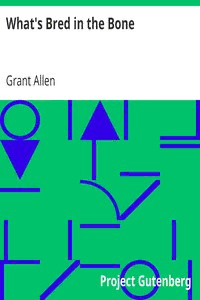
What's Bred in the Bone by Grant Allen
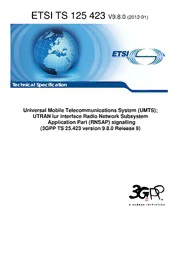
TS 125 423 - V9.8.0 - Universal Mobile Telecommunications System (UMTS); UTRAN Iur interface Radio Network Subsystem Application Part (RNSAP) signalling (3GPP TS 25.423 version 9.8.0 Release 9)
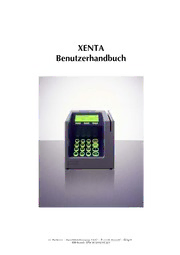
Banksys Xenta Benutzerhandbuch
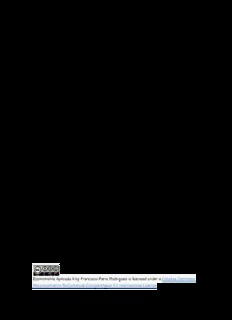
Econometría Aplicada II
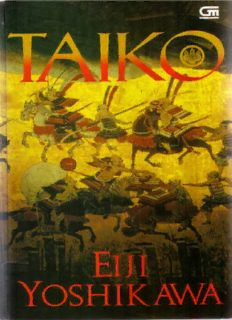
Taiko (10 buku)
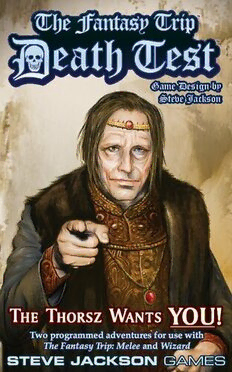
The Fantasy Trip. Death Test
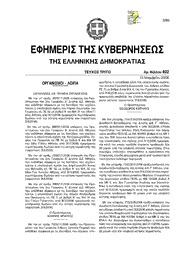
Greek Government Gazette: Part 3, 2006 no. 402
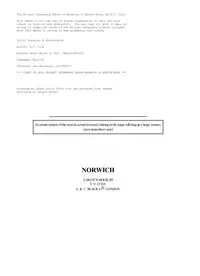
Norwich by E V Cole
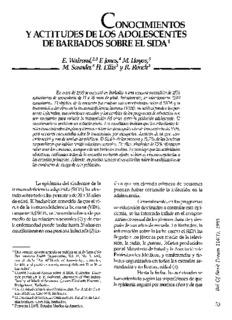
c onocimientos y actitudes de los adolescentes de barbados sobre el sida1
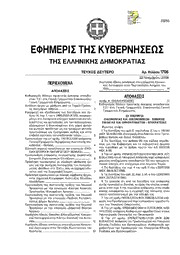
Greek Government Gazette: Part 2, 2006 no. 1706
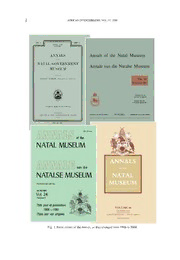
The Natal Museum and its journals : celebrating a century of publication, 1906-2005

Para Casar com o Pecado

Lake Steamy
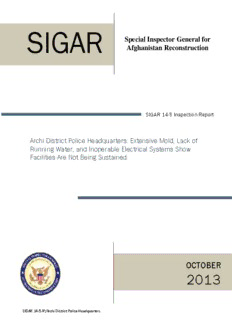
Archi District Police Headquarters - SIGAR
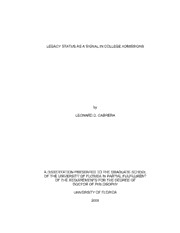
DTIC ADA462454: Legacy Status as a Signal in College Admissions
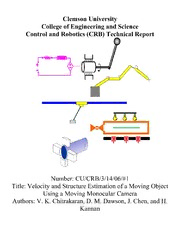
DTIC ADA462627: Velocity and Structure Estimation of a Moving Object Using a Moving Monocular Camera
